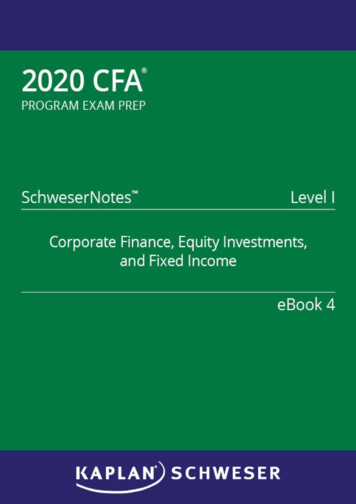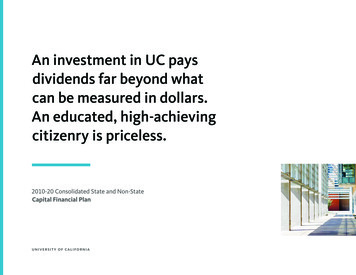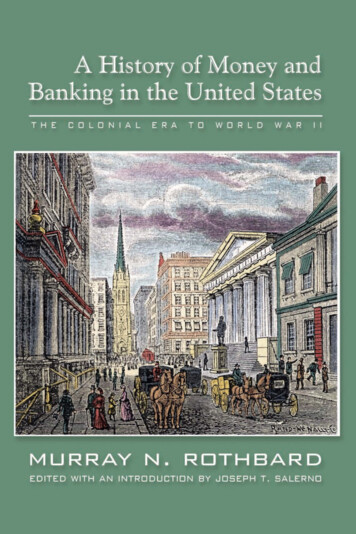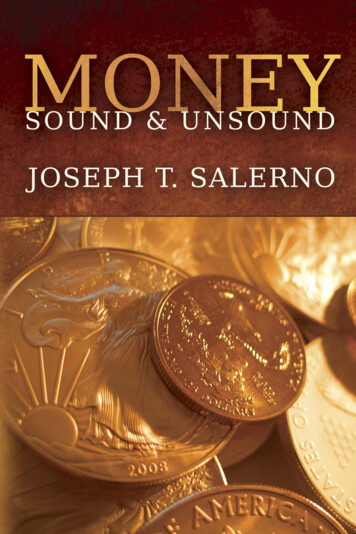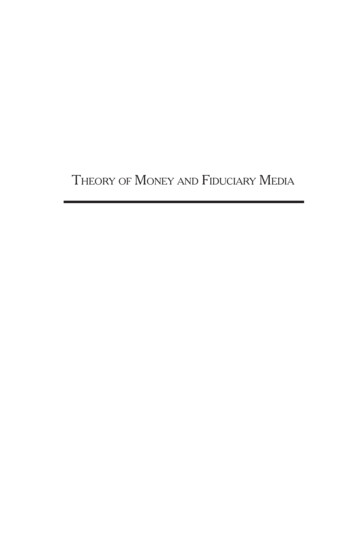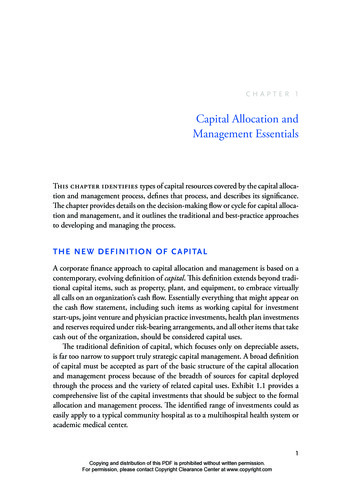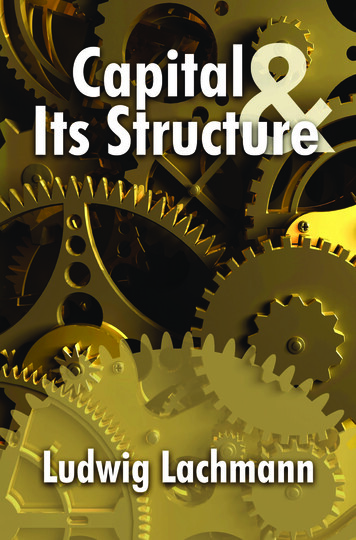
Transcription
CAPITALAND ITS STRUCTURE
CAPITALAND ITS STRUCTUREBYLUDWIG M. LACHMANNSHEED ANDREWS AND McMEEL, INC.SUBSIDIARY OF UNIVERSAL PRESS SYNDICATEKANSAS CITY
ToM.L.This edition is published in cooperation with the programs ofthe Institute for Humane Studies, Inc., Menlo Park, California;and Cato Institute, San Francisco, California.Capital and Its Structure Copyright 1978 by the Institute forHumane Studies.Jacket and cover design copyright 197ft by Cato Institute, SanFrancisco.The original edition of Capital and Its Structure was publishedby Bell & Sons, Ltd., on behalf of the London School of Economicsand Political Science in 1956.All rights reserved. Printed in the United States of America.No part of this book may be used or reproduced in any mannerwhatsoever without written permission except in the case ofreprints in the context of reviews. For information write SheedAndrews and McMeel, Inc., 6700 Squibb Road, Mission, Kansas66202.Library of Congress Cataloging in Publication DataLachmann, Ludwig M.Capital and its structure.(Studies in economic theory)Includes bibliographical references and index.1. Capital. I. Title. II. Series.HB501.L223 1978 332'.O4l77-82807ISBN 0-8362-0740-8ISBN 0-8362-0741-6 pbk.Lachmann, Ludwig M
CONTENTSCHAP.pagePREFACE TO THE SECOND EDITIONPREFACEIIIT H E ORDER OF CAPITALviixiii1O N EXPECTATIONS20IIIPROCESS ANALYSIS AND CAPITAL THEORY35IVT H E MEANING OF CAPITAL STRUCTURE53CAPITAL STRUCTURE AND ECONOMIC PROGRESS72CAPITAL STRUCTURE AND ASSET STRUCTURE86VVIVIICAPITAL IN THE TRADE CYCLE100INDEX129
PREFACEFor a long time now the theory of capital has been under acloud. Twenty years ago, when Professor Knight launchedhis attack on the capital theories of Boehm-Bawerk andWicksell, there opened a controversy which continued for yearson both sides of the Atlantic. Today very little is heard of allthis. The centre of interest has shifted to other fields.In practice of course problems concerning capital have byno means lost their interest. There can be few economists whodo not use the word 'capital' almost every day of their workinglives. But apart from some notable exceptions, economistshave ceased to ask fundamental questions about capital. It ispertinent to enquire why this has happened. It would seemthat there are three major reasons to account for this curiousneglect.In the first place, many economists have evidently come tobelieve that we do not require the conceptual framework of atheory of capital in order to discuss problems germane tocapital, or at least those problems in which practical interesthas of late been greatest, such as investment. In other words,the view appears to have gained ground that a theory of capitalis not really necessary. This, as I shall attempt to show inthis book, is an erroneous view. It is hardly possible to discussthe causes and consequences of a change in a stock without someknowledge of the nature and composition of this stock; or, it isonly possible to do so if we are prepared to abstract from allthose features of the situation which really matter. In thediscussion of capital problems, as of any other problems, wecannot dispense with a coherent frame of reference.A second reason for the present-day neglect of the theoryof capital has probably to be sought in the contemporarypreoccupation with quantitative precision of statement andargument. Most contemporary economics is presented in aquantitative garb. This is not the place to enquire into thereasons for this predilection. To some extent of course economists, in spending so much effort on quantifying the terms inxiii
PREFACEwhich they present their theories, wittingly or unwittinglymerely reflect the spirit of our age.But why should such quantification be more problematicalin the theory of capital than it is in other fields of economic study? In most business transactions capital is treatedas a quantity. In every balance sheet we find a capitalaccount.The fact remains, however, that in spite of protracted effortsit has proved impossible to find a quantitative expression forcapital which would satisfy the rigorous requirements of economic thought. Most economists agree today that, except underequilibrium conditions, a 'quantity of capital' is not a meaningful concept. In this book an attempt is made to follow upsome implications of this conclusion. But the fact that theconcept of capital has for so long proved refractory to allattempts at quantification is almost certainly one of the reasonsfor the lack of interest, and hence of progress, in the theory ofcapital.A third reason, closely related to the one just mentioned,appears to lie in the rather peculiar nature of the relationshipbetween capital and knowledge. The various uses made ofany durable capital good reflect the accumulated experienceand knowledge gained, in workshop and market, by those whooperate it. But modern economic theory cannot easily copewith change that is not quantitative change; and knowledgeis as refractory to quantification as capital is. The acquisitionand diffusion of knowledge certainly take place in time, butneither is, in any meaningful sense of the word, a 'function' oftime. Modern economists, uneasily aware of the problem,have tried to avoid it by assuming a 'given state of knowledge'.But such an assumption, if taken literally, would obviously prevent us from considering economic change of any kind. Forinstance, as Mrs. Robinson has pointed out, 'a "change inmethods of production in a given state of knowledge" is, strictlyspeaking, a contradiction in terms'. With very durable capitalgoods the assumption becomes quite untenable. Our railwaysafter all are not run by people with the technical knowledge of125 years ago.The theory of capital is a dynamic theory, not merely becausemany capital goods are durable, but because the changes in usexiv
PREFACEwhich these durable capital goods undergo during their lifetime reflect the acquisition and transmission of knowledge.Our own approach in this book follows another trend ofmodern economic thought, not towards the 'objective' andquantifiable, but towards the subjective interpretation ofphenomena. Of late many economists have exercised theiringenuity in fashioning their science in accordance with therigid canons of Logical Empiricism. Even the theory of valuehas been made to conform to the strict rules of the behaviourists:nowadays we are not supposed to know anything about humanpreferences until these have been 'revealed' to us. But few ofthese efforts have been successful. The fact remains that thetwo greatest achievements of our science within the last hundred years, subjective value and the introduction of expectations, became possible only when it was realized that the causesof certain phenomena do not lie in the Tacts of the situation'but in the appraisal of such a situation by active minds.The generic concept of capital without which economistscannot do their work has no measurable counterpart amongmaterial objects; it reflects the entrepreneurial appraisal of suchobjects. Beer barrels and blast furnaces, harbour installationsand hotel-room furniture are capital not by virtue of theirphysical properties but by virtue of their economic functions.Something is capital because the market, the consensus of entrepreneurial minds, regards it as capable of yielding an income.This does not mean that the phenomena of capital cannot becomprehended by clear and unambiguous concepts. Thestock of capital used by society does not present a picture ofchaos. Its arrangement is not arbitrary. There is some orderin it. This book is devoted to the exploration of the problemsof the order of capital.The chief object of this book is thus to rekindle interest inthe fundamental problems of capital rather than to present aclosed system of generalizations about them; to outline a newapproach and to show that it can be applied, with some promise of success, to a number of such problems ranging from theproductivity of capital to the demise of the 'strong boom'; topoint out the implications of certain economic facts whichhave been long neglected; and, above all, to emphasize thexv
PREFACEtransmission of knowledge, the interaction of minds, as theultimate agent of all economic processes.I am painfully aware of the fact that this book leaves manyvital questions unanswered. It could hardly be otherwise.But it is my hope that others will follow and make their contributions to the theory of capital. There can be few fieldsof economic enquiry today which promise a richer harvest thanthe systematic study of the modes of use of our materialresources.It is not impossible that at some time in the future the concept of capital structure, the order in which the various capitalresources are arranged in the economic system, will be given aquantitative expression; after all, any order can be expressedin numbers. For many reasons such a development would bemost welcome. But this book has been written to meet thepresent situation in which we badly need a generic concept ofcapital, but in which all attempts to express it in quantitativeterms have thus far been unsuccessful.My greatest debt of gratitude is to Professor F. A. Hayekwhose ideas on capital have helped to shape my own thoughtmore than those of any other thinker. To Professor F. W.Paish who, during his stay at this University in 1952 as a Visiting Trust Fund Lecturer, undaunted by a heavily loaded timetable, read several chapters in draft form, I am indebted formuch sagacious comment and advice. In writing the finalversion of Chapter VI I have drawn heavily on his unrivalledknowledge of the intricacies of modern business finance. Butneedless to say, the responsibility for what I say is entirely mine.I owe more than I can express in words to my friends in theUniversity of the Witwatersrand for their steady help andencouragement, in particular to Mr. L. H. Samuels and Mr.T. van Waasdijk, who patiently read draft after draft, and fromwhose helpful comment and suggestions I have derived muchunearned profit.I also wish to express my gratitude to the Research Committee of this University who by their generous financialassistance have considerably eased my task.Lastly, I have to thank the Royal Economic Society, theeditor and publishers of the Manchester School of Economic andxvi
PREFACESocial Studies, Messrs. George Allen & Unwin, the McGraw-HillBook Company, Inc., and Messrs. Routledge & Kegan Paul forpermission to quote passages from works published by them.I also wish to acknowledge my gratitude to the authors ofthese passages.L. M. LACHMANNUniversity of the WitwatersrandJohannesburgSeptember,xvii
CHAPTER ITHE ORDER OF CAPITALThe realm of economics consists of many provinces betweenwhich, in the course of time, a fairly high degree of interregional division of labour has evolved. Naturally, development in some of these regions has been faster than in others.There are some 'backward areas', and a few of them actuallyappear to merit description as 'distressed areas'. None seemsto have a better claim to this unenviable status than the Theoryof Capital. In fact it would hardly be an exaggeration to saythat at the present time a systematic theory of capital scarcelyexists.Considering the degree of division of labour just mentionedthis surely is an astonishing state of affairs. There can hardlybe a field of economic thought, pure or applied, in which theword 'capital' is not more or less constantly employed. Wehear of a world-wide capital shortage. In discussions on theconvertibility of currencies we are asked to distinguish between'current' and capital transactions. And it is clear that the'economic integration of Western Europe' requires that someat least of the industrial resources of these countries be regrouped and change their form; in other words, that it entailsa modification of Europe's capital structure.Yet, in the Theory of Capital the present state of affairs is aswe have described it. The product imported and used by theother economic disciplines is not a standardized product. Theword 'capital', as used by economists, has no clear and unambiguous meaning. Sometimes the word denotes the materialresources of production, sometimes their money value. Sometimes it means money sums available for loan or the purchaseof assets. While to some economists 'capital' has come tomean nothing but the present value of future income streams.The conclusion suggests itself that no progress made in thetheory of capital could fail to pay handsome dividends in theform of 'external economies' to be reaped by all those whohave to work with the notion of capital.1
2CAPITAL AND ITS STRUCTUREThe root of the trouble is well known: capital resources areheterogeneous. Capital, as distinct from labour and land, lacksa 'natural' unit of measurement. While we may add headto head (even woman's head to man's head) and acre to acre(possibly weighted by an index of fertility) we cannot add beerbarrels to blast furnaces nor trucks to yards of telephone wire.Yet, the economist cannot do his work properly without ageneric concept of capital. Where he has to deal with quantitative change he needs a common denominator. Almostinevitably he follows the business man in adopting moneyvalue as his standard of measurement of capital change. Thismeans that whenever relative money values change, we loseour common denominator.In equilibrium, where, by definition, all values are consistentwith each other, the use of money value as a unit of measurement is not necessarily an illegitimate procedure.1 But indisequilibrium where no such consistency exists, it cannot beapplied. The dilemma has been known ever since Wickselldrew attention to it. 2 But in most current discussions oncapital the whole problem with its manifold implications, whichgo far beyond the confines of the theory of capital, is, as a rule,allowed to be ignored.In confronting this dilemma it seems best to start by settingforth a few fundamental facts about capital.All capital resources are heterogeneous. The heterogeneitywhich matters is here, of course, not physical heterogeneity,but heterogeneity in use. Even if, at some future date, somemiraculous substance were invented, a very light metal perhaps,which it was found profitable to substitute for all steel, wood,copper, etc., so that all capital equipment were to be made fromit, this would in no way affect our problem. The real economicsignificance of the heterogeneity of capital lies in the fact thateach capital good can only be used for a limited number of purposes. We shall speak of the multiple specificity of capital goods.1'But although, even in the analysis of a stationary equilibrium, the inclusionof the "quantity of capital" among the determinants of that equilibrium meansthat something which is the result of the equilibrating process, is treated asif it were a datum, this confusion was made relatively innocuous by the essentiallimitations of the static method, which while it describes the conditions of astate of equilibrium, does not explain how such a state is brought about.' F. A.von Hayek: Profits, Interest and Investment, pp. 83-4.2Lectures on Political Economy, Vol. I, p . 202.
THE ORDER OF CAPITAL3Each capital good is, at every moment, devoted to what inthe circumstances appears to its owner to be its 'best', i.e. itsmost profitable use. The word 'best5 indicates a position ona scale of alternative possibilities. Changing circumstanceswill change that position. Unexpected change may open upnew possibilities of use, and make possible a switch from yesterday's 'best' to an even better use. Or, it may compel a switchfrom 'present best' to 'second best' use. Hence, we cannot besurprised to find that at each moment some durable capitalgoods are not being used for the purposes for which they wereoriginally designed. These new uses may, from the point ofview of the owners of the capital goods, be 'better' or 'worse',more or less profitable than the original ones. In each casethe change in use means that the original plan in which thecapital good was meant to play its part has gone astray. Inmost of the arguments about capital encountered today thesefacts and their implications, many of them crucial to a clearunderstanding of the nature of economic progress, are almostcompletely ignored.It is hard to imagine any capital resource which by itself,operated by human labour but without the use of other capitalresources, could turn out any output at all. For most purposescapital goods have to be used jointly. Complementarity is of theessence of capital use. But the heterogeneous capital resourcesdo not lend themselves to combination in any arbitrary fashion.For any given number of them only certain modes of complementarity are technically possible, and only a few of these areeconomically significant. It is among the latter that the entrepreneur has to find the 'optimum combination'. The 'best*mode of complementarity is thus not a 'datum'. It is in noway 'given' to the entrepreneur who, on the contrary, as a rulehas to spend a good deal of time and effort in finding out whatit is. Even where he succeeds quickly he will not enjoy hisachievement for long, as sooner or later circumstances willbegin to change again.Unexpected change, whenever it occurs, will make possible,or compel, changes in the use of capital goods. It will thuscause the disintegration of existing capital combinations.Even where it opens up new and promising possibilities for someresources it will open them up for some, not for all. The rest
4CAPITAL AND ITS STRUCTUREwill have to be turned to second-best uses. It is because ofthese facts that it is impossible to measure capital. Capital hasno 'natural' measure, and value will be affected by everyunexpected change.Yet, we need a generic concept. We want to be able tospeak of 'Capital'. Logically, we can establish no systematicgeneralization without a generic concept. But we need morethan that. Unable as we are to measure capital resources,we must at least make an attempt to classify them. If therecan be no common denominator there should at least be acriterium ordinis. The stock of capital does not present a pictureof chaos; its arrangement is not arbitrary; there is some orderin it. As we saw, capital resources cannot be combined in anarbitrary fashion. Only some modes of complementarity areeconomically significant. These form the basis of the capitalorder.If our classification of capital resources is to be realistic, thecriterion of order we employ must correspond to the order inwhich these resources are in reality arranged. As all capitalresources exist for the sake of the uses to which they are, ormay be, put, this means that we must make our conceptualorder reflect the actual pattern of capital use. The elementsof this pattern are the capital combinations of the variousenterprises, and they in their totality form the capital structure ofsociety. Entrepreneurial decisions on capital combinationsare the immediate determinants of the Order of Capital,though, on a wider view, these decisions reflect, of course, thecomplex interaction of economic forces from which the entrepreneur takes his orientation. It will be our main task in thisbook to study the changes which this network of capitalrelationships, within firms and between firms, undergoes as theresult of unexpected change. To this end we must regard the'stock of capital' not as a homogeneous aggregate but as astructural pattern. The Theory of Capital is, in the lastresort, the morphology of the forms which this pattern assumesin a changing world.We may turn aside for a moment to consider how economists in the past have coped with the problem of the capitalorder.The classical economists, when they spoke of the 'stock of
THE ORDER OF CAPITAL5capital', conceived of it as homogeneous and measurable, likeany other stock. From Ricardo onwards, of course, their maininterest was in the distribution of incomes. Capital was ofimportance mainly as the 'source' of profit in the same way aslabour was the source of wages and land the source of rent.And as the rate of profit was regarded as tending towardsequality in all uses of capital, the problem was really posedonly under equilibrium conditions. For only here is therea determinate and homogeneous quantity which we may call'output', and as profit is conceived as part of homogeneousoutput, so its 'source' would appear to be equally homogeneous.The notion of a homogeneous capital stock no doubt wasborrowed, as are so many of our concepts, from accountingpractice which makes a (homogeneous) money sum appear inthe capital account. Now, the classical economists were certainly not unaware of some of the dangers of describing economic magnitudes in money terms. But in this case the dangerseemed to be avoided, and the notion of a 'real stock' gained acertain plausibility from the employment of two devices whichplayed a prominent part in the classical doctrine. On the onehand, the labour theory of value made it possible and necessary to reduce capital values to labour values, i.e. to homogeneous labour units. On the other hand, there was theconcept of the Wages Fund which not merely served to renderthe stock of capital homogeneous but also reduced all capitalgoods to consumption goods measurable in labour units.In the neo-classical schools which rose in the last threedecades of the last century the focus of interest is still distribution, explained now by the marginal productivity principle. Here factors of production of various classes betweenwhich there is no longer over-all homogeneity, though themembers of each class are still regarded as homogeneous,produce a homogeneous product. The Wages Fund isabandoned, but the new problem which emerges now thatcapital goods can no longer be regarded as consumption goodsin statu nascendi, viz. the effect of capital change on capitalvalues in terms of consumable output, is ignored.The analysis is still couched in equilibrium terms. Butcapital is no longer measured in labour, or any other cost,units, and no one ever makes it clear how capital is to be
6CAPITAL AND ITS STRUCTURE8measured'. Reasoning based on the marginal productivityprinciple can no longer be applied to capital even wherethe change is, within the framework of 'comparative statics',from one equilibrium to another. A fortiori it is impossibleto speak of capital in quantitative terms in conditions ofdisequilibrium.More recently the focus of interest in discussions on capitalhas shifted to Investment, defined as the 'net addition to thecapital stock'. Now, it is possible to define the economicforces engendering investment in terms which avoid thequantification of capital, or even the very concept of capital.Professor Lerner, for instance, has defined his 'marginalefficiency of investment' exclusively in terms of present outputforgone and future output obtained.4 But in any realisticdiscussion of the 'inducement to invest' it is clearly impossibleto ignore existing capital resources, on the use and profitabilityof which the new capital cannot but have some effect.A theory of investment based on the assumption of a homogeneous and quantifiable capital stock is bound to ignoreimportant features of reality. Owing to its very character itcan only deal with quantitative capital change, investment anddisinvestment. It cannot deal with changes in the composition ofthe stock. Yet there can be little doubt that such changes inthe composition of the stock are of fundamental importance inmany respects, but in particular with regard to the causes andeffects of investment. As long as we cling to the view that allcapital is homogeneous, we shall only see, as Keynes did, theunfavourable effects of investment on the earning capacity andvalue of existing capital goods, since all the elements of ahomogeneous aggregate are necessarily perfect substitutes foreach other. The new capital competes with the old andreduces the profitability of the latter. Once we allow forheterogeneity we must also allow for complementarity betweenold and new capital. The effect of investment on the profitability of old capital is now seen to depend on which of thevarious forms of old capital are complementary to, or substitutes for, the new capital. The effect on the complements 4 Joan Robinson: The Rate of Interest, and other Essays, p. 54.A. P. Lerner: *On the Marginal Product of Capital and the Marginal Efficiency of Investment', Journal of Political Economy, February 1953, see especiallypp. 6-9.
THE ORDER OF CAPITAL7will be favourable, on the substitutes unfavourable. The'inducement to invest' will therefore often depend on the effectthe new capital is expected to have on the earning capacity ofold capital complementary to it. In other words, investmentdecisions, as to their magnitude, and even more as to the concrete form they are likely to take, depend at each moment onthe prevailing composition of the existing capital stock. Ingeneral, investments will tend to take such concrete forms asare complementary to the capital already in existence. A realunderstanding of the investment pattern is therefore impossibleas long as we cling to the homogeneity hypothesis. Investmentis thus seen to be ultimately a problem of the capital order.At each moment it reflects, both as regards its quantitativevolume and its concrete form, the possibilities left open by theexisting capital order.We must now return to our main task in this chapter. Weshall attempt to present very briefly a preliminary view of thechief problems with which we shall be concerned in this book.The problem of capital as a 'source' of profit is not amongthem. In Chapter V, to be sure, we shall have occasion toexamine certain aspects of the theory of interest, but in the context of this book this will be to us a mere side-line. The mainsubject-matter of this book is the Capital Structure. When weturn our attention to the relationship between capital andinterest we do it for the light that interest sheds on capital, notvice versa. Those economists to whom the concept of capitalwas in the main an instrument in their search for the explanation of the interest phenomenon naturally conceived of it asa homogeneous aggregate consisting of value units. By contrast, our conception of capital is that of a complex structurewhich is functionally differentiated in that the various capitalresources of which it is composed have different functions.The allocation of these functions, and the changes which itsmode undergoes in a world of change, is one of our mainproblems.In this book we shall endeavour to outline an approach tocapital problems which is both realistic and directly based onthe definition of economic action: realistic in that we deal withthe world of unexpected change; directly based on the definitionof economic action in that we start from the fact that capital
8CAPITAL AND ITS STRUCTUREresources are scarce resources with alternative uses.5 To us thechief problem of the theory of capital is to explain why capitalresources are used in the way they are; why in a given situationsome alternatives are rejected, others selected; what governsthe choice or rejection of alternative uses when unexpectedchange compels a revision of plan. There are two broadanswers to these questions, the first of which is perhaps rathertrite, but the second of which has not as yet been given theprominent place it deserves in economic thought. The firstanswer is that, of course, capital goods must be used in such away as to produce, directly or indirectly, the goods and servicesconsumers want at prices they are prepared to pay. This is afamiliar theme. The urge to maximize profits warrants thebelief that after some trial and error capital goods will in realitybe used in such a fashion. But there is a second answer.Capital uses must 'fit into each other'. Each capital good hasa function which forms part of a plan. Capital goods with nosuch function will not be maintained. The fact that capitalgoods which do not 'earn their keep' will be discarded warrantsthe belief that a tendency towards the integration of the capitalstructure really exists. But while, on the one hand, the scopeof this phenomenon is wider than is commonly recognized, thetendency does not operate unimpeded.It is obvious that capital equipment for which no labour canbe found to work it, is useless and will be scrapped. Once weabandon the assumption that all capital is homogeneous thescope of this phenomenon is seen to extend beyond that of thecomplementarity between labour and capital. Capital equipment may have to be scrapped because no capital combinationcan be found into which it would fit.On the other hand, the scrapping of surplus capital, andconsequently the integration of the capital structure, may inreality be delayed for a number of reasons. For one thing,expectations of a future different from the present may spoilthe simplicity of our theorem. If capital owners think that8We do not wish to imply, of course, that other capital theories are not basedon, or do not conform to, the definition of economic action and the praxeologicalaxioms it entails. But all too often the link is rather tenuous.There is a 'missing link' in most equilibrium theories; they all have to assumethat, once the data are given, the problem of how equilibrium is reached hasbeen solved. By contrast we shall concern ourselves with the 'path' which menhave to follow in building up capital combinations and using them.
THE ORDER OF CAPITAL9complementary factors will be available in the future, they willprefer to wait. Moreover, for heavy durable equipment theannual cost of maintenance is probably relatively small. Thismeans that even a small profit may suffice to keep capital goodsin existence. Owners of displaced capital goods will then tryto find complementary resources by offering thei
capital, but in which all attempts to express it in quantitative terms have thus far been unsuccessful. My greatest debt of gratitude is to Professor F. A. Hayek whose ideas on capital have helped to shape my own thought more than those of any other thinker. To Professor F. W. Paish who, during his stay at this University in 1952 as a Visit-


